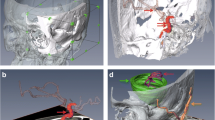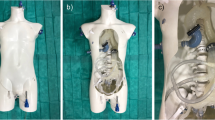Abstract
To create realistic three-dimensional (3D) vascular models from 3D time-of-flight magnetic resonance angiography (3D-TOF MRA) of an intracranial aneurysm (IA). Thirty-two IAs in 31 patients were printed using 3D-TOF MRA source images from polylactic acid (PLA) raw material. Two observers measured the maximum IA diameter at the longest width twice separately. A total mean of four measurements as well as each observer’s individual average MRA lengths were calculated. After printing, 3D-printed anatomic models (PAM) underwent computed tomography (CT) acquisition and each observer measured them using the same algorithm as applied to MRA. Inter- and intra-observer consistency for the MRA and CT measurements were analyzed using the intraclass correlation coefficient (ICC) and a Bland-Altman plot. The mean maximum aneurysm diameter obtained from four MRA evaluations was 8.49 mm, whereas it was 8.83 mm according to the CT 3D PAM measurement. The Wilcoxon test revealed slightly larger mean CT 3D PAM diameters than the MRA measurements. The Spearman’s correlation test yielded a positive correlation between MRA and CT lengths of 3D PAMs. Inter and intra-observer consistency were high in consecutive MRA and CT measurements. According to Bland-Altman analyses, the aneurysmal dimensions obtained from CT were higher for observer 1 and observer 2 (a mean of 0.32 mm and 0.35 mm, respectively) compared to the MRA measurements. CT dimensions were slightly overestimated compared to MRA measurements of the created models. We believe the discrepancy may be related to the Laplacian algorithm applied for surface smoothing and the high slice thickness selection that was used. However, ICC provided high consistency and reproducibility in our cohort. Therefore, it is technically possible to produce 3D intracranial aneurysm models from 3D-TOF MRA images.






Similar content being viewed by others
References
AHA aneurysms description. What you should know about cerebral aneurysms. Cited April 2018. Available from: https://www.strokeassociation.org/en/about-stroke/types-of-stroke/hemorrhagic-strokes-bleeds/what-you-should-know-about-cerebral-aneurysms
Fifi JT, Meyers PM, Lavine SD, Cox V, Silverberg L, Mangla S, Pile-Spellman J: Complications of modern diagnostic cerebral angiography in an academic medical center. J Vasc Interv Radiol 20:442–447, 2009
Wurm G, Tomancok B, Pogady P, Holl K, Trenkler J: Cerebrovascular stereolithographic biomodeling for aneurysm surgery. Technical note. J Neurosurg 100:139–145, 2004
Wurm G, Lehner M, Tomancok B, Kleiser R, Nussbaumer K: Cerebrovascular biomodeling for aneurysm surgery: simulation-based training by means of rapid prototyping technologies. Surg Innov 18:294–306, 2011
Kimura T, Morita A, Nishimura K, Aiyama H, Itoh H, Fukaya S, Sora S, Ochiai C: Simulation of and training for cerebral aneurysm clipping with 3-dimensional models. Neurosurgery 65:719–725, 2009
Wang L, Ye X, Hao Q, Chen Y, Chen X, Wang H, Wang R, Zhao Y, Zhao J: Comparison of two three-dimensional printed models of complex intracranial aneurysms for surgical simulation. World Neurosurg 103:671–679, 2017
Leal A, Souza M, Nohama P: Additive manufacturing of 3D biomodels as aadjuvant in intracranial aneurysm clipping. Artif Organs 43:E9–E15, 2019
Wang JL, Yuan ZG, Qian GL, Bao WQ, Jin GL: 3D printing of intracranial aneurysm based on intracranial digital subtraction angiography and its clinical application. Medicine (Baltimore) 97:e11103, 2018
Zhou LQ, Lou MW, Chen GC, Jiu ZS, Shen YX, Lu L: Value of 640-slice 3D CT angiography plus 3D printing for improving surgeries for intracranial aneurysms. Nan Fang Yi Ke Da Xue Xue Bao 37:1222–1227, 2017
Mashiko T, Kaneko N, Konno T, Otani K, Nagayama R, Watanabe E: Training in cerebral aneurysm clipping using self-made 3-dimensional models. J Surg Educ 74:681–689, 2017
Fedorov A, Beichel R, Kalpathy-Cramer J, Finet J, Fillion-Robin J-C, Pujol S: 3D slicer as an image computing platform for the quantitative imaging network. Magn Reson Imaging 30:1323–1341, 2012
Maleike D, Nolden M, Meinzer HP, Wolf I: Interactive segmentation framework of the medical imaging interaction toolkit. Comput Methods Programs Biomed 96:72–83, 2009
Parmar C, Rios Velazquez E, Leijenaar R, Jermoumi M, Carvalho S, Mak RH, Mitra S, Shankar BU, Kikinis R, Haibe-Kains B, Lambin P, Aerts HJ: Robust radiomics feature quantification using semiautomatic volumetric segmentation. PLoS One 9:e102107, 2014
Steiner T, Juvela S, Unterberg A, Jung C, Forsting M, Rinkel G: European stroke organization guidelines for the management of intracranial aneurysms and subarachnoid haemorrhage. Cerebrovasc Dis 35(2):93–112, 2013
Adams WM, Laitt RD, Jackson A: The role of MR angiography in the pretreatment assessment of intracranial aneurysms: a comparative study. Am J Neuroradiol 21:1618–1628, 2000
Hoh BL, Cheung AC, Rabinov JD, Pryor JC, Carter BS, Ogilvy CS: Results of a prospective protocol of computed tomographic angiography in place of catheter angiography as the only diagnostic and pretreatment planning study for cerebral aneurysms by a combined neurovascular team. Neurosurgery 54(6):1329–1342, 2004
Mallouhi A, Felber S, Chemelli A, Dessl A, Auer A, Schocke M, Jaschke WR, Waldenberger P: Detection and characterization of intracranial aneurysms with MR angiography: comparison of volume-rendering and maximum-intensity-projection algorithms. Am J Roentgenol 180:55–64, 2003
Sailer A, Wagemans B, Nelemans P, de Graaf R, van Zwam W: Diagnosing intracranial aneurysms with MR angiography: systematic review and meta-analysis. Stroke 45:119–126, 2014
Pierot L, Portefaix C, Rodriguez-Régent C, Gallas S, Meder J-F, Oppenheim C: Role of MRA in the detection of intracranial aneurysm in the acute phase of subarachnoid hemorrhage. J Neuroradiol 40(11):204–210, 2013
HaiFeng L, YongSheng X, YangQin X, Yu D, ShuaiWen W, XingRu L, JunQiang L: Diagnostic value of 3D time-of-flight magnetic resonance angiography for detecting intracranial aneurysm: a meta-analysis. Neuroradiology 59:1083–1092, 2017
Torres IO, De Luccia N: A simulator for training in endovascular aneurysm repair: the use of three dimensional printers. Eur J Vasc Endovasc Surg 54:247–253, 2017
Shibata E, Takao H, Amemiya S, Ohtomo K: 3D-printed visceral aneurysm models based on ct data for simulations of endovascular embolization: evaluation of size and shape accuracy. Am J Roentgenol 209:243–247, 2017
Wang L, Ye X, Hao Q, Ma L, Chen X, Wang H, Zhao Y: Three-dimensional intracranial middle cerebral artery aneurysm models for aneurysm surgery and training. J Clin Neurosci 50:77–82, 2018
Liu T, Chen M, Song Y, Li H, Lu B: Quality improvement of surface triangular mesh using a modified Laplacian smoothing approach avoiding intersection. Shi Y, editor. PLoS One 12:e0184206, 2017
Despotović I, Goossens B, Philips W: MRI segmentation of the human brain: challenges, methods, and applications. Comput Math Methods Med 2015. https://doi.org/10.1155/2015/450341
George E, Liacouras P, Rybicki FJ, Mitsouras D: Measuring and establishing the accuracy and reproducibility of 3D printed medical models. Radiographics 37:1424–1450, 2017
Kim HJ, Yoon DY, Kim ES, Lee HJ, Jeon HJ, Lee JY, Cho BM: Intraobserver and interobserver variability in CT angiography and MR angiography measurements of the size of cerebral aneurysms. Neuroradiology 59:491–497, 2017
Author information
Authors and Affiliations
Contributions
Study design: TA, MAO
Data assembly: ABK
Data analysis: MAO, AMK
Final approval of manuscript: TA, FG
Corresponding author
Ethics declarations
Conflict of Interest
The authors declare that they have no conflict of interest.
Additional information
Publisher’s Note
Springer Nature remains neutral with regard to jurisdictional claims in published maps and institutional affiliations.
Rights and permissions
About this article
Cite this article
Acar, T., Karakas, A.B., Ozer, M.A. et al. Building Three-Dimensional Intracranial Aneurysm Models from 3D-TOF MRA: a Validation Study. J Digit Imaging 32, 963–970 (2019). https://doi.org/10.1007/s10278-019-00256-6
Published:
Issue Date:
DOI: https://doi.org/10.1007/s10278-019-00256-6




